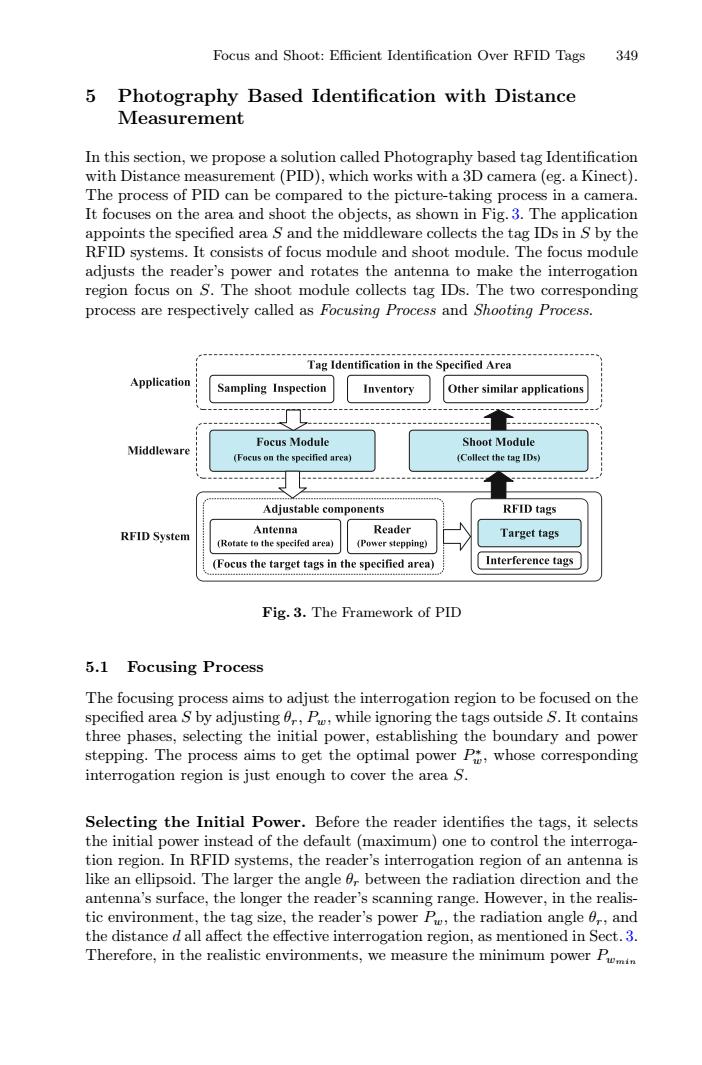正在加载图片...

Focus and Shoot:Efficient Identification Over RFID Tags 349 5 Photography Based Identification with Distance Measurement In this section,we propose a solution called Photography based tag Identification with Distance measurement(PID),which works with a 3D camera(eg.a Kinect). The process of PID can be compared to the picture-taking process in a camera. It focuses on the area and shoot the objects,as shown in Fig.3.The application appoints the specified area S and the middleware collects the tag IDs in S by the RFID systems.It consists of focus module and shoot module.The focus module adjusts the reader's power and rotates the antenna to make the interrogation region focus on S.The shoot module collects tag IDs.The two corresponding process are respectively called as Focusing Process and Shooting Process. Tag Identification in the Specified Area Application Sampling Inspection Inventory Other similar applications Focus Module Shoot Module Middleware (Focus on the specified area) (Collect the tag IDs) Adjustable components RFID tags RFID System Antenna Reader Target tags (Rotate to the specifed area) (Power stepping) (Focus the target tags in the specified area) Interference tags Fig.3.The Framework of PID 5.1 Focusing Process The focusing process aims to adjust the interrogation region to be focused on the specified area S by adjusting ,Po,while ignoring the tags outside S.It contains three phases,selecting the initial power,establishing the boundary and power stepping.The process aims to get the optimal power P,whose corresponding interrogation region is just enough to cover the area S. Selecting the Initial Power.Before the reader identifies the tags,it selects the initial power instead of the default(maximum)one to control the interroga- tion region.In RFID systems,the reader's interrogation region of an antenna is like an ellipsoid.The larger the angle 0,between the radiation direction and the antenna's surface,the longer the reader's scanning range.However,in the realis- tic environment,the tag size,the reader's power Pe,the radiation angle 0r,and the distance d all affect the effective interrogation region,as mentioned in Sect.3. Therefore,in the realistic environments,we measure the minimum power PmFocus and Shoot: Efficient Identification Over RFID Tags 349 5 Photography Based Identification with Distance Measurement In this section, we propose a solution called Photography based tag Identification with Distance measurement (PID), which works with a 3D camera (eg. a Kinect). The process of PID can be compared to the picture-taking process in a camera. It focuses on the area and shoot the objects, as shown in Fig. 3. The application appoints the specified area S and the middleware collects the tag IDs in S by the RFID systems. It consists of focus module and shoot module. The focus module adjusts the reader’s power and rotates the antenna to make the interrogation region focus on S. The shoot module collects tag IDs. The two corresponding process are respectively called as Focusing Process and Shooting Process. Fig. 3. The Framework of PID 5.1 Focusing Process The focusing process aims to adjust the interrogation region to be focused on the specified area S by adjusting θr, Pw, while ignoring the tags outside S. It contains three phases, selecting the initial power, establishing the boundary and power stepping. The process aims to get the optimal power P∗ w, whose corresponding interrogation region is just enough to cover the area S. Selecting the Initial Power. Before the reader identifies the tags, it selects the initial power instead of the default (maximum) one to control the interrogation region. In RFID systems, the reader’s interrogation region of an antenna is like an ellipsoid. The larger the angle θr between the radiation direction and the antenna’s surface, the longer the reader’s scanning range. However, in the realistic environment, the tag size, the reader’s power Pw, the radiation angle θr, and the distance d all affect the effective interrogation region, as mentioned in Sect. 3. Therefore, in the realistic environments, we measure the minimum power Pwmin